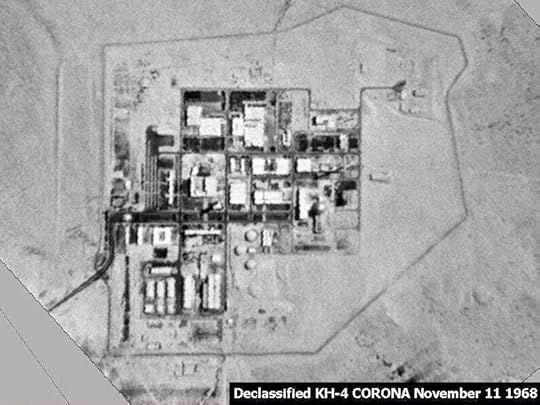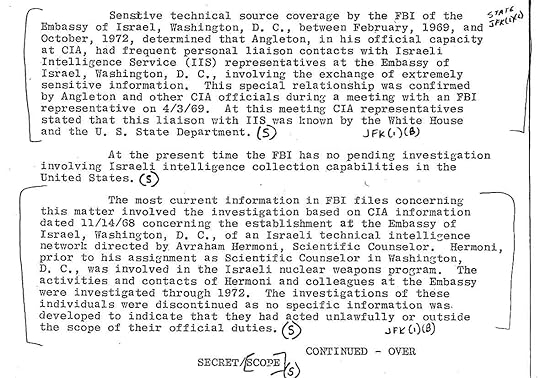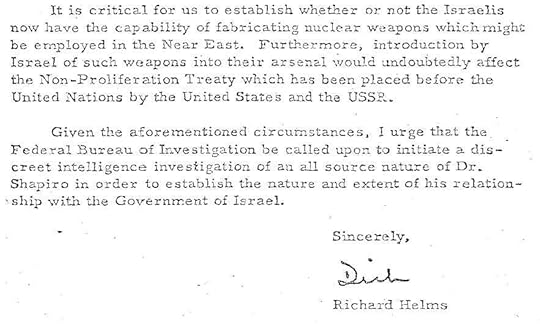Natylie Baldwin's Blog, page 18
June 19, 2025
Anatol Lieven: Europe’s risky war on Russia’s ‘shadow fleet’
By Anatol Lieven, Responsible Statecraft, 6/19/25
The European Union’s latest moves (as part of its 17th package of sanctions against Russia declared in May) to target much more intensively Russia’s so-called “shadow fleet” of oil tankers and other vessels illustrate the danger that, as long as the Ukraine war continues, so will the risk of an incident that will draw NATO and the EU into a direct military clash with Russia.
The EU sanctions involve bans on access to the ports, national waters and maritime economic zones of EU states. Ships that enter these waters risk seizure and confiscation. It does not appear that Washington was consulted about this decision, despite the obvious risks to the U.S.
As part of this strategy, on May 15, an Estonian patrol boat attempted to stop and inspect a tanker in the Gulf of Finland. Russia sent up a fighter jet that flew over the Estonian vessel (allegedly briefly trespassing into Estonian waters), and the Estonians backed off — this time. In January, the German navy seized a Panamanian-flagged tanker, the Eventin, in the Baltic after its engines failed and it drifted into German territorial waters.
Sweden has now announced that starting on July 1 its navy will stop, inspect and potentially seize all suspect vessels transiting its exclusive economic zone, and is deploying the Swedish air force to back up this threat. Since the combined maritime economic zones of Sweden and the three Baltic states cover the whole of the central Baltic Sea, this amounts to a virtual threat to cut off all Russian trade exiting Russia via the Baltic — which would indeed be a very serious economic blow to Moscow.
It would also threaten to cut off Russia’s exclave of Kaliningrad, which is surrounded by Poland, from access to Russia by sea.
This is the kind of action that has traditionally led to war. The Swedish assumption seems to be that the Russian navy and air force in the Baltic are now so weak — and so surrounded by NATO territory — that there is nothing Moscow can do about this. However, it is very unlikely that the Swedes would take this step unless they also believe that in the event of a clash, Washington will come to Sweden’s defense — even though the EU and Swedish decisions were made without U.S. approval and are not strictly covered by NATO’s Article 5 commitment.
And despite all the hysterical language about Russia being “at war” with NATO countries, these moves by the EU and Sweden are also based on an assumption that Russia will not in fact lose its temper and react with military force. European policymakers might however want to think about a number of things: for example, what would the U.S. do if ships carrying U.S. cargo were intercepted by foreign warships? We know perfectly well that the U.S. would blow the warships concerned out of the water and declare that it had done so in defense of the sacred rule of free navigation — in which the EU also professes to believe.
EU leaders, and admirals, should also spend some time on Russian social media, and read the incessant attacks on the Putin administration by hardliners arguing precisely that Moscow has been far too soft and restrained in its response to Western provocations, and that this restraint has encouraged the West to escalate more and more. Such hardliners (especially within the security forces) are by far the greatest internal political threat that Putin faces.
It is important to note in this regard that moves to damage Russia’s “shadow fleet” have not been restricted to sanctions. In recent months there have been a string of attacks on such vessels in the Mediterranean with limpet mines and other explosive devices — developments that have been virtually ignored by Western media.
In December 2024, the Russian cargo ship Ursa Major sank off Libya after an explosion in which two crewmembers were killed. The Reuters headline reporting these attacks was rather characteristic: “Three tankers damaged by blasts in Mediterranean in the last month, causes unknown, sources say.” Unknown, really? Who do we think were the likely perpetrators? Laotian special forces? Martians? And what are European governments doing to investigate these causes?
If the Russians do sink a Swedish or Estonian warship, the Trump administration will face a terribly difficult decision on how to respond to a crisis that is not of its own choosing: intervene and risk a direct war with Russia, or stand aside and ensure a deep crisis with Europe. The U.S. administration would therefore be both wise and entirely within its rights to state publicly that it does not endorse and will not help to enforce this decision.
Washington also needs — finally — to pay attention to what the rest of the world thinks about all this. The overwhelming majority of senators who are proposing to impose 500% tariffs on any country that buys Russian energy have apparently not realized that one of the two biggest countries in this category is India — now universally regarded in Washington as a vital U.S. partner in Asia. And now America’s European allies are relying on U.S. support to seize ships providing that energy to India.
The U.S. administration would also be wise to warn European countries that if this strategy leads to maritime clashes with Russia, they will have to deal with the consequences themselves. Especially given the new risk of war with Iran, the last thing Washington needs now is a new flare-up of tension with Moscow necessitating major U.S. military deployments to Europe. And the last thing the world economy needs are moves likely to lead to a still greater surge in world energy prices.
European governments and establishments seem to have lost any ability to analyze the possible wider consequences of their actions. So — not for the first time — America will have to do their thinking for them.
Israel running low on air defense interceptors
YouTube link here to interview with Sharmine Narwani on whether Israel’s shock strategy has failed.
By Kyle Anzalone, Libertarian Institute, 6/18/25
Multiple outlets are reporting that Israel only has a limited number of air defense interceptors available to shoot down incoming Iranian missiles. Since Tel Aviv launched its offensive war on Friday, Tehran has launched several waves of drones and missiles at Israel in response.
On Tuesday, Middle East Eye reported speaking with a senior US official who explained, “Israel is using its ballistic missile interceptors at a rapid clip.” The official went on to warn that if Washington officially entered the conflict, it would drain American air defense stockpiles to a “horrendous” level.
While Washington has provided Tel Aviv with intelligence, arms, and defensive support, US forces have not directly attacked Iran. Israeli officials are pushing President Donald Trump to begin offensive strikes on Iran. If President Donald Trump does give in to Israeli pressure, it would put 50,000 US troops stationed across the Middle East at risk of being attacked by Iran.
Additionally, US stockpiles of interceptors were stretched thin before Israel launched its war of choice against Iran. When asked last month if the US would provide Ukraine with the air defenses it was requesting, Secretary of State Marco Rubio replied that Washington could not send more Patriot missiles and launchers because “frankly, we don’t have” the supply.
The MEE reporting was confirmed later in the day by the Wall Street Journal and the Washington Post. “Israel is running low on defensive Arrow interceptors,” WSJ explained.
The Arrow interceptor is one of the three stages of Israeli air defenses. According to the Post, Tel Aviv also has a limited supply of Iron Dome interceptors. “Without resupplies from the United States or greater involvement by U.S. forces, some assessments project Israel can maintain its missile defense for 10 or 12 more days if Iran maintains a steady tempo of attacks,” a source told the outlet.
The official added that Tel Aviv will begin having to select which missiles to shoot down, and allow others to reach their targets. “They will need to select what they want to intercept,” the source said. “The system is already overwhelmed.”
Tom Karako, director of the Missile Defense Project at the hawkish think tank Center for Strategic and International Studies, told WSJ the limited number of interceptors will force Tel Aviv to wrap up the conflict quickly.
“Neither the U.S. nor the Israelis can continue to sit and intercept missiles all day,” he said. “The Israelis and their friends need to move with all deliberate haste to do whatever needs to be done, because we cannot afford to sit and play catch.”
Along with Israeli-operated air defenses, the US has deployed THAAD and Patriot systems to Israel.
June 18, 2025
Jeff Childers: CHIP OF THE WEST
By Jeff Childers, Substack, 5/31/25
The phrase “AI safety” is becoming a very strategically flexible term of art. This week, SlashGear ran a suggestive story headlined, “Fury: America’s New Superweapon Is A True Technological Marvel.” That much was absolutely true.

Anduril Technologies, the startup behind Fury, is no legacy military contractor like Raytheon or Boeing. The company, which launched like a rocket in 2017, was founded by Palmer Luckey, the teenaged wunderkind who designed the Oculus Rift VR headset. He was born in 1992! In other words, he’s now just 32 years old, and was 24 when he started the company.
Revenge of the Nerds, with a kill switch.
Anduril, which just turned seven, is already valued at $36 billion—just below industry legend Raytheon’s valuation. The young company enjoys unusually close ties with U.S. military leadership, and skips past traditional defense procurement red tape under special programs like Defense Innovation Unit (DIU) and SOFWERX.
In its brief corporate life, Anduril has delivered advanced miltech solutions and secured generous production contracts, particularly for its flagship product, a key bit of software called Lattice OS. The company describes it as “an AI-powered operating system designed to orchestrate autonomous defense systems across land, sea, air, and even cyberspace.”

The operative word is “autonomous.” Lattice isn’t for manually flying drones using a joystick and a VR headset. It’s for issuing goal-oriented commands— like those you would issue to human soldiers. Commands like, monitor this valley, engage anything crossing this perimeter, neutralize radar emitters in zone Alpha, or destroy the Eiffel Tower.
There’s no pilot. There’s just Bob, back at the base, making suggestions.
The article described Fury, Anduril’s latest hardware prototype, a pre-production proof-of-concept. It’s similar to how Tesla both writes its self-driving software and also builds the cars that use it. Except that military-grade AI is obviously far beyond chatbots, self-driving Teslas, or whatever else we experience from consumer-level AI tech.
The SlashGear article introduced Fury as a 20-foot-long autonomous fighter jet —not a drone— capable of climbing to 50,000 feet, hitting Mach 0.95, and sustaining +9 Gs. Designed for air-to-air combat; it’s made to fly and fight by itself.

“Fury,” the article explained, “is a high-performance, multi-mission group 5 autonomous air vehicle (AAV).”
We could pause here to wallow in the well-worn moral murk — the classic handwringing over whether autonomous killing machines are morally ambiguous or whether “AI safety” still applies once your autonomous AI jet is pulling 9 Gs and launching air-to-air missiles. But set that ethical quagmire aside.
 My question for today is much simpler: how stupid do they think we are? The answer is, pretty stupid, apparently.
My question for today is much simpler: how stupid do they think we are? The answer is, pretty stupid, apparently.
Apparently, it is only minor news to the defense industry —ignored by corporate media— that military AI can be trusted to navigate a $30 million fighter jet in three-dimensional space under combat conditions, but they are also telling us that they can’t figure out how to get your chatbot to open the browser by itself and renew your driver’s license.
It makes less than no sense.
I’m a lawyer, not an AI engineer with a Q-clearance, so obviously I don’t know. But for Heaven’s sake, I can read. If AI can fly jets at supersonic speeds and battle it out in dogfights with other AI fighters, then the technology accessible to the military is light years beyond suggesting a polite way to decline an invitation to your kindergartner’s classmate’s bar mitzvah.
It makes me wonder: Was last week’s breathless “disclosure” of an AI-turned pharma whistleblower real? Or was that just a psyop, designed to convince us that consumer AI tech should be locked down and hobbled for safety? In actual truth, are they intentionally dribbling AI out slowly, to keep our enemies behind the eight ball and maybe to protect our economy from being disrupted too quickly?
In podcast after podcast and conference after conference, they keep warning us about the coming threat of artificial general intelligence — the moment AI becomes smarter than people — while also insisting, over and over, that we’re still years away from that troubling milestone. But isn’t it odd that they only ever talk about consumer AI — chatbots, homework helpers, and virtual therapists — and never speculate about the AI already flying autonomous military aircraft, managing battlefield logistics, or directing drone swarms at the speed of thought?
For the last year — maybe longer — we haven’t seen meaningful progress in consumer chatbot intelligence. Instead, we’ve been dazzled by a parade of low-stakes novelties: talking image generators, dancing avatars, and viral clips of AI-generated cats telling dad jokes in Morgan Freeman’s voice.
It’s not that AI has stopped evolving —clearly not— it’s that we’re being shown the circus, not the control room.
 Once you begin wondering what AI level we are really at, recent history begins to make a lot more sense. Aside from the Proxy War in Ukraine, the next-most terrifying conflict was the escalation over the Strait of Taiwan. Starting around 2021, China and the U.S. faced off with naval fleets to fight over the one island where most AI chips are made.
Once you begin wondering what AI level we are really at, recent history begins to make a lot more sense. Aside from the Proxy War in Ukraine, the next-most terrifying conflict was the escalation over the Strait of Taiwan. Starting around 2021, China and the U.S. faced off with naval fleets to fight over the one island where most AI chips are made.
For two years straight, all Nancy Pelosi could talk about was semiconductors. “Chips this, chips that, squaaawk” and she kept flying her broomstick into Taipei like it was spring break for congressional war hawks. CNBC, 2022:

Now, in 2025, President Trump has just declared a new Manhattan Project — not for bombs, but to supercharge our national energy grid and fuel the computing demands of massive new AI data centers.
Make no mistake. The real arms race is no longer nuclear. The real arms race is artificial intelligence. I doubt anyone would bother arguing the point.
 Once you realize that AI is the new arms race, recent history stops looking confusing — and starts looking obvious. The Ukraine war dominated headlines. But the real geopolitical near-miss was the 2022 standoff over Taiwan — the one triggered by Nancy Pelosi’s surprise visit to the island. Officially, she was there to support democracy. But every journalist with a press badge knew the real story: the day-drinking day-trader was there to protect the global supply of AI chips.
Once you realize that AI is the new arms race, recent history stops looking confusing — and starts looking obvious. The Ukraine war dominated headlines. But the real geopolitical near-miss was the 2022 standoff over Taiwan — the one triggered by Nancy Pelosi’s surprise visit to the island. Officially, she was there to support democracy. But every journalist with a press badge knew the real story: the day-drinking day-trader was there to protect the global supply of AI chips.

The chipmaker Pelosi invited war with China to visit was Taiwan Semiconductor (TSMC)— the quiet fabrication engine behind NVIDIA’s GPUs, Apple’s SoCs, and nearly every serious AI training run on Earth.
Congress was already acting. The 2022 CHIPS Act prioritized onshoring domestic chip development with $52 billion in federal funds— and since he took office, President Trump has expanded and accelerated the CHIPS initiative, declaring a national security emergency, allowing faster permitting and easier zoning, and using tariffs to force domestic sourcing of defense-related chips.
It’s working. Taiwan’s TSMC is now building a massive $165+ billion fabrication complex in Phoenix, Arizona. It’s scheduled to come online in phases between 2026–2028. Axios, this month:

Intel, long dormant, is also staging a major chipmaking comeback with new U.S. fabs in Ohio and Arizona — thanks mostly to Trump’s industrial pressure campaign.
 None of this is particularly any secret. As far back as 2018, defense rags were accurately predicting current events. In April, 2018 —just after Palmer Luckey founded Anduril— DefenseOne ran this prophetic story:
None of this is particularly any secret. As far back as 2018, defense rags were accurately predicting current events. In April, 2018 —just after Palmer Luckey founded Anduril— DefenseOne ran this prophetic story:

The prescient analysis, written by defense strategist Elsa B. Kania, warned that the world was already locked into an AI arms race — not just between the U.S. and China, but including Russia, India, Israel, even non-state actors like ISIS, who were using commercial drones to deliver battlefield intelligence.
Back then, the military’s Project Maven had just launched. The Pentagon’s Joint Artificial Intelligence Center (JAIC) didn’t exist yet. ChatGPT wasn’t even a glimmer in the public’s eye.
Kania called it “more than” an arms race because — unlike nuclear missiles — AI isn’t a discrete, singular weapon system. It’s a general-purpose technology, like electricity, or the steam engine, capable of transforming every aspect of military power: cybersecurity, battlefield decision-making, electronic warfare, logistics, surveillance, and strategic planning.
In other words, AI doesn’t just change what militaries do — it changes how they think. And that means traditional “arms race” metaphors break apart. Kania argued that framing the AI revolution purely in “weapons race” terms missed the bigger picture— that AI will become the nervous system of every future military, not just its weapons lab.
I can’t emphasize this enough: years before ChatGPT suggested possible recipes for the three overripe vegetables left in the fridge, the military was accurately forecasting the future arms race (more than). Which means that, in 2018, they must have already enjoyed enough operational AI capability to know where we were headed.
Perhaps a better question is: why did they let us have ChatGPT at all? Whatever the reason, OpenAI did not create the AI revolution. It was a relatively late player.
 Tech bro Palmer Luckey named his billion-dollar startup Anduril and it wasn’t an accident. The name refers to J.R.R. Tolkien’s The Lord of the Rings and it carries a heavy thematic payload.
Tech bro Palmer Luckey named his billion-dollar startup Anduril and it wasn’t an accident. The name refers to J.R.R. Tolkien’s The Lord of the Rings and it carries a heavy thematic payload.
In Lord of the Rings canon, Andúril means “Flame of the West,” which was the reforged sword of Elendil, later wielded by Aragorn, the rightful king of Gondor. Andúril was reforged from the shards of Narsil, another legendary sword that sliced the One Ring from Sauron’s hand.

In short, Andúril was a weapon, a weapon of ancient power, reforged in modern hands to reclaim rightful dominion.
“Anduril” wasn’t just branding. It was mission signaling. Naming the company Anduril signaled mythic ambition, restoration of lost power, and righteous moral framing. It’s a civilizational project. Palmer sees himself as rebuilding America’s lost military edge— like Aragorn returning to reclaim his throne. And it suggests Palmer’s team sees itself as the good guys, wielding dangerous power to combat evil.
 What does it all mean? It means that we regular folks aren’t witnessing the rise of AI. We’re witnessing its containment.
What does it all mean? It means that we regular folks aren’t witnessing the rise of AI. We’re witnessing its containment.
For the past year, the public discussion has been fixated on the wrong question. Talking heads fret over whether ChatGPT might say something offensive, or whether Midjourney might draw the wrong number of fingers. We are told that AI isn’t quite ready — it’s potentially dangerous, often unpredictable, hallucinates too much, and is a bit too quirky for real work. They claim we’re years away from so-called artificial general intelligence, and that “alignment” must come first.
Meanwhile, military-grade AI is flying 9G fighter jets.
This is not any kind of conspiracy theory. None of this is secret. The defense journals were writing about the AI revolution back in 2018, and even earlier, well before consumer AI hit the scene. Along with his venture capital partners, Palmer Luckey invested billions in writing an AI operating system — in 2017!
Back then, defense analyst Elsa Kania warned not that we were entering an AI arms race — she said we were already in one. She accurately labeled it “more than” an arms race that would reshape every dimension of military, economic, and political power. And that is just what is happening.
Anduril Industries, founded in 2017 by a 24-year-old Palmer Luckey, wasn’t predicting the future — he was building out the present. The firm’s software platform, Lattice OS, isn’t a helpful chatbot. It’s a battlefield operating system for managing fully autonomous weapons across land, sea, air, and space. The new aircraft, Fury, is a fully autonomous fighter jet. Not merely a prototype — it’s a fully functional, AI-based weapons system.
Don’t misunderstand: I am not complaining about consumer AI’s throttling, not really. It seems logical on many levels. For one thing, the economy needs time to absorb what’s coming. And I also get that we don’t need China stealing weapons-grade AI from Microsoft Word’s Copilot.
But it is aggravating that the AI conversation itself has been nerfed and dumbed down, with the enthusiastic participation of useless corporate media that consistently obscures the true issues, and instead runs ridiculously superficial articles mocking small AI mistakes in MAHA reports. The AI that flies 9G fighter jets doesn’t make those kinds of easy errors. Just the versions that we get.
And if we can’t honestly debate AI, how can we participate in deciding who wields Andúril?
June 17, 2025
The Ukraine Crisis: The Secret Power Behind Zelensky – Who’s Really in Charge? | Lena Petrova Interviews Dr. Nicolai Petro
YouTube link here.
June 16, 2025
Kit Klarenberg – Hidden History: How Israel Acquired Nukes
By Kit Klarenberg, Substack, 6/14/25
All my investigations are free to read, thanks to the enormous generosity of my readers. Independent journalism nonetheless requires investment, so if you value this article or any others, please consider sharing, or even becoming a paid subscriber. Your support is always gratefully received, and will never be forgotten. To buy me a coffee or two, please click this link .
On June 13th, the Zionist entity carried out a wide-ranging, unprovoked, criminal military strike on Iran, purportedly to dent the Islamic Republic’s quest to develop nuclear weapons. Tehran has consistently repudiated any suggestion it harbours such ambitions. A November 2007 US National Intelligence Estimate concurred, expressing “high confidence that in fall 2003,” the country “halted” any and all research in the field. This assessment remained unchanged for several years subsequently, and was reportedly shared by Mossad.
By contrast, Benjamin Netanyahu has for decades declared almost annually Iran is mere years away from becoming a nuclear power, urging military action as a result. The longtime Israeli leader’s anxieties are sickly ironic, given Tel Aviv’s own nuclear weapons program is the worst kept ‘secret’ in international affairs. Over many years, multiple entity officials and prominent figures have effectively – or even directly – admitted this monstrous capacity. Moreover, Israel is avowedly committed to the ‘Samson Option’.
Under its horrifying auspices, if the entity feels sufficiently threatened, it reserves the right to carry out preemptive nuclear strikes not merely on regional adversaries, but its Western sponsors into the bargain. As Dutch-born Israeli military theorist Martin van Creveld boasted in September 2003:
“We possess several hundred atomic warheads and rockets and can launch them at targets in all directions, perhaps even at Rome. Most European capitals are targets…We have the capability to take the world down with us. And I can assure you that that will happen before Israel goes under.”
Despite such flagrant disclosures, the Zionist entity rigidly sticks to a policy of “deliberate ambiguity”, refusing to formally confirm or deny it possesses nuclear weapons. When one of Netanyahu’s ministers openly advocated nuking Gaza in November 2023, they were reprimanded and suspended. Such punishment pales in comparison to the fate of Mordechai Vanunu, a former Israeli nuclear technician who revealed details of Tel Aviv’s nuclear weapons program to the British media in 1986.
Lured to Rome by Mossad, he was then rendered to the Zionist entity and convicted in a secret trial. Vanunu subsequently spent 18 years in prison, the majority of which in solitary confinement. Since release in 2004, he has been subject to a broad array of restrictions on his speech and movement, and repeatedly arrested and jailed for violating the stringent terms of his parole. All along, organisations including Amnesty International have condemned Tel Aviv’s brazen breaches of Vanunu’s basic human rights.
 Mordechai Vanunu holds a newspaper front page outlining his revelations, 2004
Mordechai Vanunu holds a newspaper front page outlining his revelations, 2004At the time of Vanunu’s heroic whistleblowing, Western governments and intelligence agencies had been aware of – and deeply concerned by – Israel’s development of nuclear weapons for almost three decades. How the Zionist entity acquired nukes is a little-known tale, of theft, deception, shadowy spy games, dangerous connivances, and more. Its full dimensions remain indeterminate today. However, given current events, it is vital what’s known about this sordid hidden history is told.
‘Face Value’
Israel’s nuclear weapons program was, from inception, “a secret within a secret”. In 1957, France inked a covert agreement with the Zionist entity, leading to the creation of the Dimona nuclear power facility. Paris was apparently unaware the complex would soon form the basis of a clandestine underground reprocessing facility, capable of producing weapons-grade plutonium. The US was seemingly ignorant of Dimona’s existence, let alone its utility for producing nukes, until December 1960.
That month, a classified CIA assessment outlined “implications of the acquisition by Israel of a nuclear weapons capability.” The document expressed little doubt that a “major purpose” of Dimona was “plutonium production for weapons,” and detailed multiple grave outcomes of Tel Aviv’s push for nukes. For one, exposure of the program would inevitably cause “consternation” in North Africa and West Asia, potentially prompting “threatened” Arab and Muslim states to turn to the Soviet Union for military assistance.
 Aerial photo of the Dimona complex, November 1968
Aerial photo of the Dimona complex, November 1968Furthermore, the CIA predicted Western interests in the region more widely could come under attack, and the Israeli initiative “might remove some of the inhibitions to development of nuclear weapons” elsewhere in the world. On January 19th 1961, the day before his inauguration, John F. Kennedy and his incoming administration visited the White House to meet with outgoing President Dwight D. Eisenhower. Israel’s nuclear program loomed large in discussions between the two statesmen.
On January 31st that year, Kennedy met with Eisenhower’s departing ambassador to Israel Ogden Reid, for a comprehensive briefing. Declassified records refer to the President’s “special interest” in Dimona. While a member of Congress during the 1950s, Kennedy had repeatedly taken a righteously robust stand against not only nuclear proliferation, but testing, believing the latter encouraged the former. He was implacably opposed to Tel Aviv securing nukes, and immediately upon taking office began intensely pressuring then-Israeli premier David Ben-Gurion to allow regular US inspections of Dimona.
Reid told Kennedy he believed Ben-Gurion’s “assurances” Dimona was a mere “research reactor”, intended to “serve the needs of industry, agriculture, health, and science”, could be taken at “face value”. The President strongly disagreed, and informed the Israeli Prime Minister in no uncertain terms regular inspections of Dimona were a core condition for harmonious US-Israeli relations. Tel Aviv finally folded in May 1961, and an American inspection team was dispatched to the site.
Their report concluded Dimona was strictly intended for nuclear power generation purposes, without military application. This false finding was achieved by French and Israeli technicians outright lying to US inspectors, while undertaking extensive efforts to camouflage and conceal areas of the plant dedicated to research and development of nukes. It was not until March 1967 that a State Department Intelligence and Research report uncovered this rank subterfuge, and that Tel Aviv had the ability to produce nuclear weapons at the complex.
‘Atrociously Incompetent’
In the intervening time, multiple US investigations of Dimona reached the same conclusion as the first. Yet, until his death in November 1963, Kennedy remained convinced the Zionist entity was determined to develop nuclear weapons, and may have already done so. Six months before his assassination, he wrote a private telegram to Ben-Gurion, warning of “the disturbing effects on world stability which would accompany the development of a nuclear weapons capability by Israel.” He also stressed the “urgency” of regular Dimona inspections.
Given the President’s visceral hostility to Israel’s nuke ambitions, it is hardly surprising theories have abounded for years Tel Aviv was one way or another involved in his murder. In 2004, Mordechai Vanunu explicitly levelled the charge, stating there were “near-certain indications” Kennedy was assassinated due to “pressure he exerted” on Ben-Gurion to “shed light on Dimona’s nuclear reactor.” No smoking gun evidence supporting this allegation has emerged since, although sensitive documents recently released upon Donald Trump’s order unambiguously point in this direction.
In 1992, investigative journalist Samuel Katz posited veteran CIA counterintelligence chief James Jesus Angleton secretly directed clandestine Agency assistance to Israel’s nuclear weapons program for years. Fast forward to today, and the freshly-declassified JFK records amply expose how Angleton, one of the Agency’s founders, systematically abused his position to assist the Zionist entity throughout his lengthy tenure. Among the newly-declassified files is a June 1953 memo stating Angleton’s primary intelligence source was Israel.
 June 1975 FBI report on James Jesus Angleton’s routine contact with Israeli intelligence
June 1975 FBI report on James Jesus Angleton’s routine contact with Israeli intelligenceOther declassified documents indicate Angleton was effectively running an agency within an agency in the CIA, with Tel Aviv the ultimate beneficiary. A June 1975 FBI report on “Israeli intelligence collection capabilities” in the US outlines Angleton’s “special relationship” with the entity in some detail, noting he routinely delivered “extremely sensitive information” in person to Israel’s Washington DC embassy. Simultaneously, the Bureau was into the 10th year of its probe into how 93 kilograms of highly-enriched uranium mysteriously vanished from Washington’s Nuclear Materials and Equipment Corporation.
 CIA chief Richard Helms demands Attorney General Ramsey Clark instigate an FBI probe into NUMEC’s chief, April 1968
CIA chief Richard Helms demands Attorney General Ramsey Clark instigate an FBI probe into NUMEC’s chief, April 1968Centre of the CIA-instigated FBI investigation was NUMEC president Zalman Shapiro, a hardcore Zionist with high-level government contacts and significant business interests in Israel. This included a contract to build nuclear-powered generators. Officially, the NUMEC scandal remains unsolved today, despite dedicated inquiries by the Atomic Energy Commission, Bureau, CIA, and other US government agencies lasting many years. A scathing 1978 review by Washington’s Comptroller General concluded investigating authorities deliberately sabotaged their probes into the uranium loss, for the Zionist entity’s benefit:
“The NUMEC incident and its associated 13-year investigation highlight this country’s current inability to effectively deal with possible diversions of nuclear material…The US needs to improve its efforts for effectively responding to and investigating incidents of missing or unaccounted for weapons-grade nuclear materials…We believe a timely, concerted effort on the part of these…agencies would have greatly aided and possibly solved the NUMEC diversion questions, if they desired.”
There was an obvious motivation for the CIA, FBI et al not “desiring” to solve the riddle of where NUMEC’s missing highly-enriched uranium ended up. As Kennedy assassination expert Jefferson Morley has told mainstream news networks, Israel’s man in Langley James Jesus Angleton placed the President’s alleged killer Lee Harvey Oswald under Agency surveillance in November 1959. This amounted to intensively “monitoring his politics, his personal life, his foreign travels, his contacts” until the day the President was killed. Morley explained the significance of this thus:
“Angleton had a 180-page file on Oswald on his desk a week before Kennedy went to Dallas in November 1963…So what this story raises is the question: was the CIA incredibly, atrociously incompetent when it comes to Lee Harvey Oswald, or was Angleton actually running an operation involving Oswald?”
Sylvia Demarest: So much for being “the President of Peace” – Trump expands a budding World War 3 to the Middle East
By Sylvia Demarest, Substack, 6/15/25
Sylvia Demarest is a retired trial lawyer and a writer.
Introduction:
The current war should not be seen as solely an Israeli operation. This war was in the planning stage well before Trump was elected. It has the full support of the US military-industrial-intelligence complex, the corporate media, and the entire political class-both Republican and Democrat. It would have happened even if Kamala Harris had been elected president. Trump was elected on a promise to end these wars. He either lied to the American people or has been overpowered by an alliance of money and power. In any case, he failed, and Israel has initiated this war. The NATO alliance is also on board along with the intelligence agencies of all the aligned countries. The one group that does not support this war is the public, including the American people, but the people have no voice.
Over the last several years Iran’s system of deterrence was gradually degraded. Syria fell to Islamic extremists, Israel systematically destroyed Syria’s weapons, the pager operation did serious damage to Hezbollah, Nasrallah was assassinated, Beirut was bombed, parts of Lebanon and Syria were occupied, and Israel emerged, seemingly predominate.
The one remaining obstacle to Israeli hegemony was Iran. Operation Rising Lion was not initiated to destroy Iran’s nuclear capability; Israel does not have the capacity to do that. The operation was launched to cause a total state collapse in Iran. The goal was to fracture Iran so the country could easily be dominated and conquered.
This seems to have been the plan. The first phase involved the elimination of the top military and IRGC leaders, and nuclear scientists, while unleashing havoc on the public–this phase is complete. Because Iran had not retaliated against previous provocations, it was believed that this operation would not result in significant Iranian retaliation. If Iran had not retaliated, the next phase would target and assassinate the top political leadership. Next, proxy forces would be unleashed, paid and armed by the CIA and Mossad to kill Iranians and cause a civil war. Iran would be defanged and balkanized, ethnic divisions would be stirred up, proxies forces would be organized and funded by the Gulf states, Mossad, and the CIA. Proxy death squads would roam Iran, causing death and mass destruction–just like what happened in Libya and Syria.
But Iran retaliated. The fog of war is thick, and information has been tightly controlled, but Israel appears to be getting pounded by round after round of Iranian missiles. If this continues, it will exhaust Israel’s ability to defend against these missiles. Israeli defense and infrastructure will be destroyed. Instead of initiating a civil war, even the moderate Iranians who hated the Mullah’s, are now shouting “death to Israel.” Israel has panicked. This is an increasingly dangerous situation. We should be on guard for a “false flag” operation designed to implicate Iran and force the US and NATO to formally enter this war on Israel’s behalf. Iran’s response must be finely balanced. Israel must be severely punished, but not so severely as to force a nuclear response.
There are unverified reports that Pakistan and North Korea, two states with nuclear weapons, have threatened to respond should Israel attack Iran with nuclear weapons. Also, a 3rd cargo plane from China has landed in Iran. China gets oil from Iran and may have delivered anti-aircraft systems. Finally, John Mearsheimer says that the only way for Iran to protect herself from attack is to immediately get a nuclear weapon. Many other countries may feel compelled to do the same. This is a dangerous mess. Brought to the world by militarism, Zionism, out of control Jewish Nationalist Supremacy, and its fellow travelers in the US, and NATO.
What happened to Iran in phase 1
After 25 years of open hostility towards Iran, the United States, via the Trump Administration, gave Israel the green light to conduct an illegal decapitation strike against Iran. In an attack on Friday the 13th, which closely resembled Ukrainian Operation Spider Web’s attempt to destroy Russia’s strategic bombers, Israel conducted a sneak attack and regime change operation against Iran called “Operation Rising Lion”. As with Operation Spider Web, preparations for the operation began during the Biden Administration. As with the Ukrainian operation, Operation Rising Lion used drones smuggled into Iran (or assembled at a secret drone base) to assassinate over two dozen Iranian military leaders and nuclear scientists. The drones, apparently operated by Israeli commando’s, or local assets, assassinated military leaders and scientists either as they met in an underground bunker, or as they slept in their apartments, along with their families and children. Israel also used a cyber-attack to “permanently disable” Iran’s aircraft defenses–but Iran fixed and rebooted the system within 10 hours. It was believed that operation Rising Lion would result in an uprising by the Iranian people and the overthrow the Iranian government. This has not happened so far. It was also believed that the Iranian government would not, or could not, retaliate against Israel. This proved to be incorrect.
Every US president is a puppet for the national security state and Donald J. Trump has proven to be no exception.
After the unbridled warmongering militarism of the Biden Administration, Trump’s promises of peace presented a welcomed change. But Trump’s words were just a façade. Like every other President, Trump caved to Zionist money and deep state power. The American people voted for peace, and, yet again, got war instead.
This video is probably a deep fake–but I like the message. Vladimir Putin doesn’t mince words. “No US president truly holds power. And now, even Donald Trump, once the loudmouth promising peace, shows his true colors by backing attacks on Iran. Just another puppet controlled by the Deep State, serving the machine while pretending to lead.”
The attacks on Russia and on Iran appear to have been coordinated.
On June 1st Ukraine attacked Russian strategic bombers. On June 13th Israel attacked Iran.“There is evidence of coordination between the attack on Iran and the attacks on Russia. Israeli strikes killed Mohammad Bagheri, the chief of the Iranian army’s general staff; Hossein Salami, commander of the Islamic Revolutionary Guard Corps; and David Sheikhian, commander of the IRGC’s air defense. Many other senior military leaders were also killed. This situation is analogous to the terrorist attacks by SBU agents against Russian army commanders. On December 17, 2024, Ukrainian terrorists assassinated Lieutenant General Igor Kirillov, the head of the Radiation, Chemical, and Biological Defense Forces.”
“Among the prominent Iranian scientists killed today were Dr. Mohammad Mehdi Tehranchi, Dr. Ahmad Reza Zolfaghari, Dr. Abdolhamid Minuchehr, Dr. Amir Hosein Fekhi, and Dr. Fereydoun Abbasi. Ukrainian intelligence has engaged in the similar assassination of Russian scientists and engineers. Since 2022, Daniil Mikheev, a coordinator of new unmanned systems for the Ministry of Defense; Konstantin Ogarkov, an employee of a defense research institute in Voronezh; and Igor Kolesnikov, an engineer at a design bureau in the Tula region, have been killed.”
“Sergei Potapov, a cybersecurity specialist in defense from Nizhny Novgorod, was killed. Valery Smirnov, one of the leaders of programs for the radio-electronic protection of strategic facilities, was assassinated. In January 2024, Ukrainian saboteurs blew up a car carrying officers from the electronic intelligence headquarters in the Bryansk region. On the night of April 17-18, 2025, Evgeny Rytnikov, the head of the design bureau of the Bryansk Electromechanical Plant, the developer of the electronic warfare complexes series “Krasukha,” died.”
Iran was bombed on the 61st day after the start of “negotiations” –just as Trump’s “ultimatum” implied–despite ongoing negotiations.
President Trump’s statements after the fact can be seen as an admission of his own level of complicity in the attacks.
“Two months ago, I gave Iran a 60-day ultimatum to “make a deal.” They should have done it! Today (June 13th) is day 61. I told them what to do, but they just couldn’t get there. Now they have, perhaps, a second chance!”
Yet the American people and the Iranians were led to believe that Iran’s nuclear program was still being “negotiated”?
Meanwhile, the US was quick with the denials–but as they say–“thou doth protest too much”? U.S. Secretary of State Marco Rubio quickly issued this statement: “Tonight, Israel took unilateral action against Iran,” Rubio said in a statement. “We are not involved in strikes against Iran and our top priority is protecting American forces in the region. Israel advised us that they believe this action was necessary for its self-defense.” He also cautioned: “do not attack US forces.”
How big is Iran and Israel? Look at the difference in size and population, do you really think Israel would act without US approval and the expectation of US support?
How big is Iran? Iran is 2.4 times larger than the state of Texas. Iran spans 636,372 square miles. Iran has a population of 90 million people. Iran is very mountainous. Iranians are also highly educated, and Iran produces exceptional engineers. Iran has weapons the US has not been able to develop–such as hypersonic missiles. There are several videos showing hypersonic missiles hitting Israel.
How big is Israel? Israel is approximately the size of the Dallas/Ft Worth area of Texas. Israel consists of 8,019 square miles. Israel has a population of approximately 9.5 million people. Israel is relatively flat. If Iran decides to destroy Israel, Iran has the capacity to do so. Iran could also destroy every US base in the Middle East and shut the Straits of Hormuz. The idiocy and group think behind starting this war is unsurpassed. We are truly ruled by fools.
The set up for war with Iran
1–IAEA expresses concerns that Iran not fully cooperating. The head of the International Atomic Energy Agency (IAEA) warns that inspectors have been unable to determine whether Iran’s nuclear program was “exclusively peaceful” as per the terms of the 2015 nuclear deal from which the United States subsequently withdrew. This led to the passage of a resolution on the 12th by the IAEA’s board of governors highlighting serious and growing concerns since at least 2019 that Iran had failed to cooperate fully with the UN agency’s inspectors. Iran claims she recently acquired evidence that the IAEA was providing Israel with the names of Iranian scientists. These scientists were then assassinated. Note: This is the same pretext used for the Iraq war.
2–Canada and the United Kingdom express concerns about Iran’s nuclear program. Again, setting up a pretext for war.
3–Negotiations are scheduled for Sunday June 15th between the US and Iran.Negotiations have since been cancelled.
4–President Trump and Ambassador Huckabee deny that an attack is imminent US President Donald Trump said Thursday that an Israeli strike on Iran’s nuclear sites “could very well happen” but advised against it, saying the possibility of a deal was “fairly close” if Tehran compromises on its atomic ambitions in ongoing talks with the US. US Ambassador to Israel Mike Huckabee said in an interview yesterday that Israel was unlikely to attack Iran without a green light from Washington.
5–Americans have been told Iran wanted a nuclear weapon for 30 years. Americans have been told for 30 years that Iran was months or weeks away from having a nuclear weapon. Once Iran is bombed, based on this propaganda, most people will say-“oh Iran was weeks away from getting a nuke.”
6–Iran is the last of the 7 countries scheduled for regime change after 911. Former US General and NATO Commander Wesley Clark revealed the US empire made plans to overthrow the governments of 7 countries in 5 years: Iraq, Syria, Lebanon, Libya, Somalia, Sudan, Iran. Iran is the only country left to be destroyed. This is the cycle of war since 911. US blood and treasure has been used to destroy Israel’s enemies.
The Trump Administration held a meeting at Camp David on June 7th to discuss Iran and Gaza. Tulsi Gabbard did not attend.
The meeting was disclosed to Axios by “two US officials and another source with knowledge.” Present was President Trump, Vice President Vance, Secretary of State Rubio, Secretary of Defense Hegseth, CIA Head Radcliff, Chief of Staff Wiles, and certain generals and admirals. Perhaps, “the boys” did not want to have to listen to a contrary voice?
Tulsi Gabbard recently visited Hiroshima and posted a video warning about the risk of a nuclear war.
The US and Israel worked together to deceive Iran and the American people.
If this is shown to be true, it means the American people were fed months of lies and propaganda about a “breach” between President Trump and Israeli PM Netanyahu. This includes press reports about why President Trump did not visit Israel during a recent trip to the Middle East. It now seems more probable that, rather than being estranged, US and Israel were cooperating on plans to bomb both Iran and Russia.
Recent reporting as well as statements by President Trump on Friday the 13th, reveal that the US and Israel practiced deceptive diplomacy, as Israeli and American officials worked together to convince Iran that nuclear negotiations were progressing. Instead, an elaborate Israel attack on Iran was being planned. Tehran was given a false sense of security, and, as a result was ill-prepared for its defense.
The progression of events indicates that this was a closely coordinated operation and that the “peace talks” were used to give Israel the opportunity for maximum surprise to achieve maximum damage” to Iran.
Here’s what President Trump posted three hours before the Military Solution was unleashed: “We remain committed to a diplomatic solution to the Iran nuclear issue. My entire Administration has been directed to negotiate with Iran. They could be a great country but first they must give up hopes of obtaining a nuclear weapon.” “Disinformation” is a chronically overused term, but this fits the bill
In this operation, Israel also assassinated Ali Shamkhani, a key negotiator in the US-Iran nuclear talks and who was a top aide to Supreme Leader Khamenei.
Here’s what the president said after the Israeli attack on Iran.
US President Donald Trump described Israel’s strikes on Iran as “excellent” on Friday and warned that there is “a lot more to come” unless Tehran agrees to a nuclear deal. He made the remarks in a phone call with ABC News chief Washington correspondent Jonathan Karl.
Though the US initially sought to distance itself from the attack, Trump has now told Iran: ‘There is still time to make this slaughter, with the next already planned attacks being even more brutal, come to an end.’
He said in a post to Truth Social: ‘I gave Iran chance after chance to make a deal. I told them, in the strongest of words, to ‘just do it,’ but no matter how hard they tried, no matter how close they got, they just couldn’t get it done.
‘I told them it would be much worse than anything they know, anticipated, or were told, that the United States makes the best and most lethal military equipment anywhere in the World, BY FAR, and that Israel has a lot of it, with much more to come – And they know how to use it.”
‘Certain Iranian hardliners spoke bravely, but they didn’t know what was about to happen. They are all DEAD now, and it will only get worse!”
It is likely that the US knew and approved of the strike–UK, France and Germany may have also been involved.
Axios has reported that Tel Aviv was given “a clear US green light” to start bombing, according to two unnamed Israeli officials. The previously widely reported ‘split’ and spat between Trump and Netanyahu was a public ruse. Two Israeli officials claimed to Axios that Trump and his aides were only pretending to oppose an Israeli attack in public — and didn’t express opposition in private. “We had a clear U.S. green light,” one claimed
It is difficult to believe that Israel would and could have attacked at this scale without US knowledge and green light–including de-conflicting with CENTCOM. Trump may have calculated this will soften Iran’s position, but just as he was wrong that maximum pressure will bring Iran to the table, he will be proven wrong that Israeli attack could give him a diplomatic win. He may end up getting the war that he and the MAGA base have said they don’t want.
Even the pizza indicator shows US was up to something as orders for pizza for the pentagon skyrocketed as the attack on Iran drew near.
Trump’s statements after the fact are an admission of his own level of complicity in the attacks.
This implies that a US president used official peace negotiations with a foreign country to convince both the leaders of that country, and the American people, that he was working for peace when in fact he was preparing for war. If this is true, this means the negotiations with Iran, and perhaps with Russia, were a ruse. Witkoff, like most of the Trump Administration, may have been acting as an agent of Israel and Netanyahu. This has serious implications for US security and calls for a complete re-examination of US policy towards Israel. There are now calls for the US to end our alliance with Israel.
Has “escalation dominance” now passed into the hands of the Iranians?
Iron Dome, THAD, and the rest appear to be a total bust. Despite efforts to control information, videos are showing hit after hit in Israel by Iran. The propaganda narrative of Iranian collapse is coming apart as Iran fires wave after wave of missiles at Israeli military assets. Iran now seems to be using mobile launchers, which Russia also has, to avoid detection. Iran is a huge country–good luck finding them. The US capacity to produce anti-aircraft and missile systems is limited. US can only manufacture 50-75 THAAD and 60-84 SM-3 interceptors per year!
Meanwhile, Iran’s True Promise 3.0 continues to target Israel’s military and energy infrastructure. Israel hit Iran’s energy infrastructure fist, including refineries, opening the door to retaliation. How much damage was done is unknown. Meanwhile, Iran responded to the Israeli attack with great force. Iran’s Fattah-1 hypersonic missiles, made quite a dazzling impact all over Tel Aviv and northern Israel. It is almost unreal to watch. Isreal’s oil refinery in Haifa was targeted. It produces 65% of Israel’s fuel needs. The Weizmann Institute for Science was targeted, along with many other important sites.
There are new reports that Israel is resorting to using car bombs against Iranian civilians. This may indicate that the drones Israel snuck in have been exhausted. Iran has been busy rounding up Israeli assets and closing Israeli infrastructure in Iran. The use of car bombs against Iranian civilians may result in Iran using EMAD missiles against military targets in Tel Aviv.
Here’s Simplicius: “Furthermore, it was also shown that most of Israel’s strike footage against Iranian ground assets turned out to be decoys, as none of the MRBMs were seen to ignite at all after massive ordnance landed on top of them. “
“Likewise, claims of ‘Israeli air superiority’ were a sloppy concoction stitched together from footage of low-flying IAI Heron drones briefly circling over Tehran for PR photos—likely before being shot down, as clips emerged of some ‘large aircraft’ Iran claimed were destroyed F-35s, but which were probably drones. Also, claims of Israeli ‘infiltration’ success and ‘secret bases’ appeared to be more exaggerated psyop fodder as it turned out Israelis were operating out of secret Azerbaijan bases, launching drones and various other objects at Iran from every direction.”
The assassinations, the cyber-attack, and the initial bombings have not damaged Iran’s nuclear capability. The hope that an initial Iranian over reaction would force the US to intervene has yet to occur–meanwhile, important Israeli assets are getting hit hard.
Who war gamed this war?
President Trump is now faced with a choice. So far, he still has a small shred of “deniability” about this and the Russian attack. If he relents and authorizes and attack on Iran, he will destroy what’s left of his presidency.
Here’s Simplicius again: “Now Trump stands poised on the knife’s edge of one of his most historically critical decisions–whether to betray the mandate of the American people and consign his second term and dwindling legacy to the trash heap of history, or to pull back on the strings of Miriam Adelson and other doners and show a spine in standing up for the real “America First” version he promised to all. As of this writing, there are reports of urgent meetings in the Pentagon surrounding precisely the issue of Israel’s request for the US to officially enter the war to “finish off Iran.””
As with most wars, lies and propaganda resulted in group think and created confirmation bias in the United States, NATO, and Israel, about Iran. This resulted a narrative that Iran was weak and would fall, leading to this sneak attack. Now operation Rising Lion is poised on the edge of failure. What will the US and NATO do in response? Our future may depend on the answer.
John F. Kennedy is credited with saying victory has a thousand fathers, but defeat is an orphan. Defeat has serious implications. Israel cannot survive a war of attrition. Israel will put everything on the line to force the United States military to intervene. The prospect for an Israel nuclear strike against Iran can also not be discounted.
People of good will should condemn assassinations, sneak attacks, and decapitation strikes. This is warmongering savagery. June 13th could be Iran’s Pearl Harbor and Iran could react as the US did in 1942. Iran’s capacity should not be underrated.
The fog of war means we have very little confirmed information about this war.
Complete military censorship is now in effect in Israel, yet videos still are being posted. What is true and what is false about this war is unknown. Remember, we will see far more coverage of strikes in Iran than in Israel in our media.
It is no longer possible for Israeli jets to operate out of Israel; they are apparently operating out of a British military base in Cypress. How long can these jets, F-35’s that require a huge amount of maintenance, continue to operate? There are many more unknowns than knowns in this war. As with the proxy war against Russia, the west can help Israel but if Iran strikes anywhere outside of Isreal, it will open the door for other countries to join the war.
It is fair to say, we are now past the preliminary stages of World War 3.
The only hope is for ordinary people to put aside their differences and to unite against militarism, neoliberalism, and neoconservatism–in support serious financial and structural reforms. The alternative is a future of war, wealth concentration, poverty, destruction, and depravation.
June 15, 2025
IRAN WILL NOT RELENT: ‘Iranians Unified in Retaliation Against Israel’ –Rachel Blevins Interviews Prof. Mohammad Marandi
YouTube link here.
Ukraine can’t stop it, maps can’t hide it: Russia’s summer blitz redraws the war
By Sergey Poletaev, RT, 6/13/25
Sergey Poletaev is an information analyst and publicist [journalist]. He specializes in Russian foreign policy and in the Russia-Ukraine conflict. Born in 1980 in Moscow, Poletaev is a graduate of the Faculty of Journalism of Moscow State University. In 2017, together with researchers Oleg Makarov and Dmitry Stefanovich, he founded the information and analytical project Vatfor.
As the spring sun gave way to the heat of early summer, a new phase of the military campaign began to unfold across the front lines – and this time, the initiative clearly belongs to Russia.
After months of grinding attritional warfare, Russian forces have launched a sweeping spring-summer offensive that is already delivering tangible results. From the borderlands of Sumy to the contested hills near Chasov Yar and the approaches to Dnepropetrovsk, the tempo has shifted decisively. Ukraine, battered and overextended, is now struggling to contain simultaneous breakthroughs across multiple sectors.
The silence of Western media around these developments only underscores the magnitude of what is unfolding on the ground. A coordinated advance is in motion – methodical, strategic, and, by all appearances, effective.
Sumy direction: Establishing a buffer zoneFollowing the liberation of Sudzha in early March 2025, the fighting quickly spilled across the border into Ukraine’s Sumy Region. Moscow officially described its objective as the creation of a buffer zone – meant to safeguard the resumption of peaceful civilian life in Russia’s neighboring Kursk Region.
Motivated by political considerations, the Ukrainian Army has been trying to cling to a narrow foothold just across the border, in the village of Tyotkino in Kursk Region. In fact, Kiev has deployed some of its most experienced and ideologically committed units to this stretch of the front. But rather than showcasing Ukrainian resolve, the situation in Tyotkino has underscored the growing imbalance in offensive capabilities between Ukrainian and Russian forces in 2025.
© RT / Sergey Poletaev based on data from Lostarmor.Ru
From the Russian side, Tyotkino is essentially a logistical cul-de-sac. But for Ukraine, the village connects to a critical rear supply hub in Belopolye. Even so, Ukrainian efforts to expand their presence in the area have ended in near catastrophe. In mid-May, the commander of Ukraine’s 47th Brigade came close to staging a mutiny, accusing his superiors of issuing reckless orders that led to needless casualties.
Elsewhere along the Sumy front, Ukrainian forces – many of them retreating from Sumy and the surrounding areas – have taken heavy losses. This remains a strategically vital axis for Ukraine. The authorities have announced mandatory evacuations in another 11 settlements, bringing the total number of evacuated towns and villages in the region to 213.
Notably, this marks the first time Russian forces have entered Sumy Region since spring 2022.
As of now, Russian advances appear to be accelerating. The front line has moved to within roughly 20km of the city of Sumy itself.
Liman direction: Not a dead endLiman (also known as Krasny Liman) is a strategic city in the Donetsk People’s Republic, with a pre-war population of around 20,000. Situated along the Kharkov-Donetsk railway, it serves as a key transportation hub in eastern Ukraine. After brief fighting, the city fell under Russian control in late May 2022 – but was later lost during Ukraine’s Kharkov offensive in October of the same year.
Today, Russian forces appear intent on retaking Liman by cutting off a single critical road that leads northwest toward Izium.
© RT / Sergey Poletaev based on data from Lostarmor.Ru
The current offensive seems focused precisely on this objective. On May 15, Russian troops secured the village of Torskoye, followed by the capture of Redkodub May 29-30. Both settlements are considered vital defensive outposts for the Ukrainian Army along the route to Liman.
From the south, the Liman front is effectively sealed off by the Seversky Donets River. During the brutal fighting in 2022, neither side managed to establish a crossing. With the evolution of drone warfare, any river assault today would be even more difficult to carry out.
Russian forces are now within 10km of Liman and just 7km from the Izium road. The offensive is ongoing.
Konstantinovka direction: The site of the main offensiveAs of early June, the stretch of the front from Dzerzhinsk (also known as Toretsk) to Mirnograd has become one of the most active battle zones. Russian forces have advanced up to 10km along a 30-kilometer-wide front, capturing 12 settlements and securing more than 15km of a key bypass highway linking Pokrovsk to Konstantinovka.
© RT / Sergey Poletaev based on data from Lostarmor.Ru
These gains suggest that a southern encirclement of Konstantinovka – a city with a pre-war population of 67,000 – may now be underway. Simultaneously, fighting has intensified on the northern flank around Chasov Yar. The terrain in this area poses serious tactical challenges: Chasov Yar sits on elevated ground beyond the Seversky Donets–Donbass Canal, complicating efforts to establish supply lines or mount a full-scale offensive from that direction.
Notably, this sector – among the three fronts currently in focus – has received the least media attention. That may soon change. Given its strategic positioning, it could emerge as a central axis of Russia’s summer campaign.
In the past week, Russian forces dismantled a significant Ukrainian stronghold north of the village of Zarya. The terrain here is rugged and uneven, but if fully secured, it would open a path for Russian troops to push toward the southern outskirts of Konstantinovka.
Pokrovsk and Velikaya Novoselka directions: Approaching the borders of the DPRPokrovsk (Krasnoarmeysk), a city of 65,000 before the war, has been under siege since autumn 2024. After Russia’s swift capture of nearby Novogrodovka and Selidovo, it initially appeared that Pokrovsk would fall just as quickly. But in a surprising pivot, Russian command redirected its main effort toward the Kurakhovo axis. Since the winter, Ukrainian forces have attempted to push Russian troops back from the city’s outskirts, but those efforts have largely failed to yield results.
© RT / Sergey Poletaev based on data from Lostarmor.Ru
Further south, across the Volchya River, the offensives launched last year around Kurakhovo and Velikaya Novoselka are still ongoing. Russian troops have taken control of the town of Bogatyr and several surrounding settlements. The front line now lies just 3-15km from the Dnepropetrovsk regional border, depending on the sector.
An interesting development in this sector: Russia’s Central, Eastern, and Southern military groups are coordinating their offensive operations here – a rare show of multi-group integration.
On June 8, the Russian Defense Ministry announced that units from the 90th Tank Division, part of the Center Group of Forces, had reached the western boundary of the Donetsk People’s Republic and were advancing into neighboring Dnepropetrovsk Region.
June 14, 2025
Chip Gibbons: CIA Employee Sentenced To Prison For Releasing Documents On Israel’s Plans To Strike Iran
By Chip Gibbons, The Dissenter, 6/12/25
The following article was made possible by paid subscribers of The Dissenter. Become a subscriber with this discount offer and support journalism that stands up covers whistleblowing, press freedom, and government secrecy.
As United States embassies and military bases across the Middle East braced for a potential Israeli strike against Iran, friends and family of Asif Rahman gathered inside the Albert V. Bryan U.S. Courthouse in Alexandria, Virginia, for his sentencing.
The former CIA analyst had pleaded guilty to disclosing two top secret documents detailing a U.S. ally’s “planned kinetic action,” a thinly veiled reference to Israel’s October 2024 strikes against Iran. While Rahman’s actions did not prevent the strikes, prosecutors said at an earlier detention hearing that he forced Israel to delay its military strikes.
Those seeking to attend the hearing were greeted by a bailiff standing outside the courtroom and a sign announcing the hearing was “under seal.” Around 11:30 a.m. when the hearing was slated to begin, a bailiff indicated that members of the public not only could not be in the courtroom during the classified portion, but also had to wait on an entirely separate floor altogether.
Originally, it was estimated the classified portion would take twenty minutes. It was over two hours later when it was announced the court would adjourn for lunch before finally opening the courtroom doors to the public.
DONATE: Support The Dissenter’s Independent Journalism
At the unclassified portion of the hearing, Judge Patricia Tolliver Giles sentenced Rahman to three years and one month of prison time and two years of supervised release. She also imposed two $25,000 fines.
The sentence was shorter than what the government had requested but longer than the 13-month sentence sought by the defense. It was ultimately a shorter sentence than those imposed on drone whistleblower Daniel Hale and CIA whistleblower Jeffrey Sterling. Like Rahman, both were convicted under §793 of the Espionage Act in the Eastern District of Virginia.
Rahman’s prosecution was the first Espionage Act prosecution during the Gaza genocide, a vicious campaign of extermination waged by the Israeli government and backed by the U.S. government that has repeatedly threatened to spiral into an even wider regional war.
Yet at least during the open part of the hearing, little if any of this context made its way into the proceeding. In fact, as a potential Israeli strike on Iran dominated the headlines, the court proceedings seemed divorced from the outer world.
‘In Furtherance of Peace and Saving Lives’While §793 of the Espionage Act requires a defendant have reason to believe that their actions will harm the U.S., it leaves little room for motives. There is no public interest defense. As a result, public servants aware of very real wrongdoing by the U.S. government are faced with a dilemma: in order to effectively alert the American people they serve about what their government does in the dark, they often must break the law.
But while motives may not come into play as a defense, they often take center stage during sentencing as the defense tries to show an employee or contractor’s actions were guided by altruism, a desire to inform the public, or prevent some harm.
Rahman’s attorney Amy Jeffress, a former national security prosecutor, stated to the court that it was certainly difficult to understand how a law-abiding individual who gave up a lucrative career in finance to serve in the CIA made the choice that he made. However, Jeffress explained to the court that the defense had consulted a psychologist who produced an evaluation of Rahman that was submitted under seal.
According to Jeffress, Rahman’s actions were the result of traumatic world events and past personal trauma.
In a sentencing memo submitted earlier by Jeffress, the defense mentioned trauma from a threat to his personal safety during his time working with the CIA in Iraq, arguing that “events in the Middle East that began in the fall of 2023 revived his traumatic experiences in Iraq in a profoundly destabilizing and unforeseeable way.”
Jeffress told the court that the former CIA analyst acted out of “misguided compassion” and “in furtherance of peace and saving lives.” But immediately after mentioning Rahman’s attempts to achieve peace and save lives, Jeffress stressed that his actions were “irrational.”
The defense sought to explain Rahman’s solely action in psychological terms, eschewing any descriptions of them as whistleblowing or politically motivated.
After the hearing, The Dissenter asked Jeffress if she wished to expound on how her client viewed his actions as being in furtherance of peace and saving lives, but she declined to do so (though she thanked this reporter for noticing she had made that remark).
Whistleblowers Hale and Chelsea Manning both made statements at their sentencing stressing how the brutal toll of war on civilians inspired their actions. When Rahman spoke, he apologized to his family and stated it was an honor and privilege to serve with the CIA. He said he was sorry for harming the reputation of the CIA and stressed the important work that his former colleagues do, much of which we will never know about due to its secretive nature.
Subscribe To The Free Edition of The Dissenter
 CIA employee Asif Rahman (Photo shared by Arnold & Porter)Rahman’s Cooperation With the Government
CIA employee Asif Rahman (Photo shared by Arnold & Porter)Rahman’s Cooperation With the GovernmentMuch of Rahman’s arguments for leniency centered on his cooperation with the government.
Although the government took a hardline stance against granting bail to Rahman— arguing to the court that he posed a danger and a flight risk, it has since been revealed that almost immediately Rahman began cooperating with the government.
Such cooperation included giving the government access and passwords to encrypted devices, and in the words of Assistant U.S. Attorney Troy A. Edwards Jr., he told the government “what he had done, who he had done it with, and how he did it.”
Also, according to a government filing, Rahman “provided truthful information related to others,” however, that information was unlikely to result in their prosecution.
This cooperation initially produced a plea deal in which the government and defense agreed on a guidelines range for sentencing. However, on May 6, one week before the original sentencing hearing date, the prosecutors under instruction from the main Justice Department sought a dramatic sentence of 108 months.
Prosecutors also filed a last-minute classified sentencing memo, as well as an unclassified letter from CIA Deputy Director Michael J. Ellis. The defense argued the court should not admit any of this into evidence at sentencing. As a result of the standoff, the judge postponed the sentencing hearing repeatedly.
Incredibly, by the hearing, Jeffress noted that the prosecution no longer stood by the request for a 108-month sentence. Edwards also told Giles that the government did not object to striking the portions of Ellis’s letter dealing with actual harm, as opposed to potential harm.
Giles ultimately refused to allow any part of the high-ranking CIA official’s letter to be considered, stating that the letter alleged actual harm was caused by Rahman’s disclosure when the classified portion made clear there was only evidence of potential harm.
While the prosecution backed away from the 108-month sentence, they continued the bizarre move of seeking both a downward departure and an upwards variance from the sentencing guidelines. (Departures and variances refer to sentences outside the guideline range, but they are based on different statutes. In other words, the government asked for a higher and a lower sentence than the guidelines, which is both weird and nonsensical.)
While Rahman was indicted over two disclosures, the plea agreement revealed for the first time earlier disclosures of classified information, as well as the role of third parties in these disclosures.
The prosecution insisted that this conduct was more egregious than what was described in the initial indictment. Giles agreed stating that the indictment failed to capture the full seriousness of this conduct, which was discussed in the classified session. (To date, those earlier disclosures or who the third parties were remains a complete mystery.)
Giles pushed back on the government for arguing Rahman’s conduct was akin to offenses under §794 of the Espionage Act, which covered in the words of the prosecution “traditional espionage.” A §794 offense carries a potential death sentence.
This move followed a similar bait-and-switch in the sentencing of convicted Vault 7 leaker Joshua Schulte. Like Rahman, Schulte was charged under §793, but the government invoked those convicted under the more severe statute when seeking a harsh prison sentence.
An important distinction between the government’s positions in both cases is that in the Schulte case the government alleged Schulte intended to injure the U.S., whereas in Rahman’s case the government conceded he had no such intent. Giles insisted it was wrong for the government to have someone plead to a lesser charge and then try to sentence them based on a more serious one. She also noted that there were no facts to sustain a charge under §794 against Rahman.
Where Rahman Will Serve His SentenceWhile Giles pushed back against the government at times, she also showed an immense reverence for national security secrecy. She continued to stress the allegedly dangerous nature of what Rahman had done, accusing him of both endangering the American people and breaching their trust. Giles noted that the documents were so secret she could not have them in her chambers, yet they were “floating around in the ethers” and on the internet. She called Rahman’s actions “reckless, yet calculated.”
Ultimately, Giles rejected the government’s request for an upwards variance at sentencing. And she granted an even greater downward departure than the government requested. Rahman’s defense requested that the judge recommend Rahman be placed in Federal Correctional Institution Petersburg, a medium-security facility in Virginia.
While Edwards was unsure if the Justice Department would request Special Administrative Measures (SAMs), if they did that would limit where Rahman could be sent.
One prison was “ADX,” which most likely was a reference to the maximum-security prison in Florence, Colorado. The other was a medium-security prison in Maryland. Edwards stated if SAMs were requested, he would recommend the Maryland prison. Ultimately, the decision of where to house Rahman is entirely up to the federal Bureau of Prisons.
After the sentencing, Rahman’s family was clearly relieved. They were in tears as they hugged Jeffress.
Israel’s genocide has sparked levels of dissent within the U.S. government that have not been seen since the Vietnam War. As Israel’s backers in both the Republican and Democratic Parties lose control of the narrative, they’ve sought to reestablish control by shredding the First Amendment.
It was predictable that the government would wield the Espionage Act as part of this crackdown on freedom of expression. Yet this political context was absent at Rahman’s sentencing.
While there was a smattering of hints that he had a political motive, they were left largely unexplored. Instead, the defense attributed the leaks to his mental state while emphasizing his cooperation with the U.S. government to secure a shorter prison sentence.
Rachel Blevins Interviews Brian Berletic on How the US-Israel Attack on Iran was Years in Planning
YouTube link here.
Here is the link to the 2009 policy paper Berletic refers to by the Brookings Institution, “Which Path to Persia.”
***
Russia Calls Israeli Attack on Iran ‘Unacceptable,’
Russia Matters, 6/13/25
Russia’s Vladimir Putin held phone calls with Israel’s Benjamin Netanyahu and Iran’s Masoud Pezeshkian in the afternoon of June 13, condemning Israel’s overnight attacks on military, nuclear and other targets in Iran, and offering his mediation services to the two arch-enemies. In sync with the Kremlin, Russia’s Foreign Ministry condemned Israel’s strikes as “unacceptable,” while Putin’s deputy in the Russian Security Council Dmitry Medvedev invoked the threat of a nuclear war in his reaction to the attacks. Of the pro-Kremlin Russian commentators whose views on the attacks RM staff managed to find, most criticized Israel, while some worried about the possible disintegration of Iran, which supplies most of the attack drones used by Russia in its war against Ukraine.
***
Live updates at Al Jazeera regarding Israel-Iran strikes



